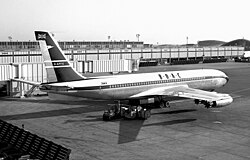 G-APFE, the aircraft involved in the accident, in 1962 with previous livery | |
| Accident | |
|---|---|
| Date | 5 March 1966 |
| Summary | In-flight break-up caused by severe turbulence |
| Site | Mount Fuji, Japan 35°19′59″N 138°48′17″E / 35.33306°N 138.80472°E |
| Aircraft | |
| Aircraft type | Boeing 707-436 |
| Operator | BOAC |
| IATA flight No. | BA911 |
| ICAO flight No. | BOA911 |
| Call sign | SPEEDBIRD 911 |
| Registration | G-APFE |
| Flight origin | Heathrow Airport, London |
| 1st stopover | Montréal–Trudeau International Airport (at the time called, Dorval Airport), Montreal, Canada |
| 2nd stopover | San Francisco International Airport, San Francisco, California |
| 3rd stopover | Honolulu International Airport, Honolulu, Hawaii |
| 4th stopover | Itazuke Air Base, Fukuoka, Japan (unscheduled) |
| Last stopover | Haneda Int'l Airport, Tokyo, Japan |
| Destination | Kai Tak Int'l Airport, British Hong Kong |
| Passengers | 113[1] |
| Crew | 11[1] |
| Fatalities | 124 |
| Survivors | 0 |
BOAC Flight 911 (call sign "Speedbird 911") was a round-the-world flight operated by the British Overseas Airways Corporation (BOAC) that crashed near Mount Fuji in Japan on 5 March 1966, with the loss of all 113 passengers and 11 crew members. The Boeing 707 jetliner involved disintegrated mid-air shortly after departing from Tokyo, as a result of severe clear-air turbulence.
It was the third fatal passenger airline accident in Tokyo in a month, following the crash of All Nippon Airways Flight 60 on 4 February and that of Canadian Pacific Air Lines Flight 402 just the day before.[2]